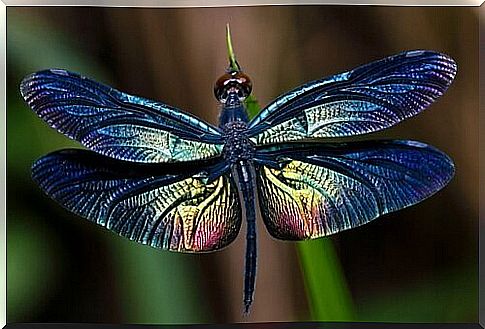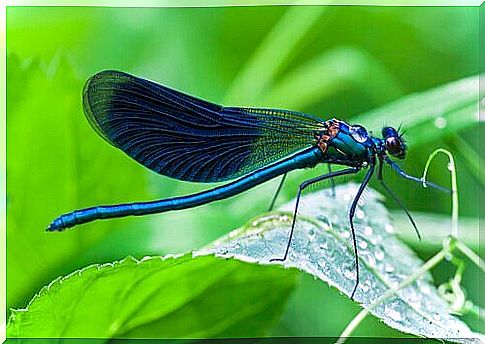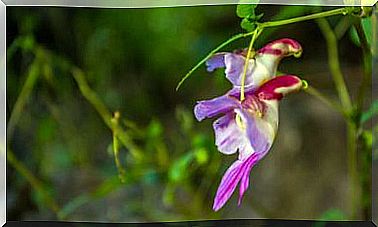Dragonflies: Learn All About This Amazing Insect

Dragonflies are carnivorous predators that play a vital role in the ecosystem. After all, they ingest a large number of mosquitoes and prevent diseases such as yellow fever or malaria.
Without a doubt, dragonflies are among the insects that most fascinated and aroused the curiosity of human beings. They are protagonists of numerous myths, beliefs and mythological stories that have inhabited the popular imagination for many centuries. Now, we will learn more about this amazing winged insect and its meaning in our culture.
Dragonflies: morphological characteristics
Currently, more than 5,500 different species of dragonflies are known. Furthermore, it is estimated that they may have appeared for the first time more than 300 million years ago. This would mean that they predate human civilization and are older than dinosaurs.
Dragonflies are characterized by their thin, elongated abdomen and large globular eyes that barely touch. Their ocular morphology gives them a truly privileged view, whose visual field can reach 360 degrees.
Dragonflies have six legs, each covered with tiny hairs, which allow them to capture their prey. Its large and impressive wings, which are four in all, can measure from two to 19 centimeters, varying according to the species.

Dragonfly Feeding
Dragonflies are very effective carnivorous predators. Naturally, they help to control the population of mosquitoes and other pests. They may be small, but they are hunting specimens that are positioned at the top of the food chain among insects. Thanks to their remarkable agility and the hair of their feet, they catch small insects during flight.
The role dragonflies play in their ecosystem helps humans a lot. A decrease in its population would be a risk not only to the balance of its habitat, but also to our health.
dragonfly habitat
The vast majority of dragonfly species are native to warm climates, particularly tropical and subtropical regions. However, they can be found on every continent except the North Pole and Antarctica. Furthermore, the time they lived on our planet is proof of endurance and adaptation.
The flight of dragonflies
Dragonflies are also well known for their great agility and endurance in flight. They have tiny rings on their abdomens that help them propel their own body, gaining strength and speed when it comes to flying.
Their light and elongated body structure, together with their four powerful wings and rings, allow them to reach great speeds. A dragonfly can fly continuously for hours without decreasing the average speed of 60 km/h . Furthermore, they can take off quickly without needing any external boost.

Dragonfly Breeding
Dragonflies live a large part of their lives near water and this is where they pair up to breed. In general, males must fight each other to “conquer” the female of a territory. And after crowning himself a “winner”, he must take care of his partner while she lays her eggs in the water.
The life cycle of every dragonfly begins in water, in the form of an aquatic nymph. During this period, they breathe through their gills and feed on worms and tadpoles.
They also have a kind of mask with large fangs to capture their prey. The duration of the “nymph phase” varies with each dragonfly species, from a few weeks to eight years.
Then comes the moment of your metamorphosis. After many skin changes, they reach the insect form they will adopt throughout their short adult life. To reach this stage, the dragonfly must get rid of its mask and fangs. Most dragonflies only live a few weeks.
The dragonfly and its meaning in popular culture
In the traditional native culture of the American continent, the dragonfly is considered a symbol of transformation and rebirth. Therefore, they are generally associated with reincarnation and the souls of the dead. There are also mentions of these insects as symbols of strength and prosperity.
The Burmese people used to regularly perform the ritual of throwing dragonflies into the waters surrounding their settlements. Currently, it is estimated that the intention was to control the mosquito population and prevent the spread of diseases such as yellow fever or malaria. This ritual took on a protective meaning for the mythology of the native people.
Furthermore, its flight and the colors that reflect on its large wings have generated real fascination in many civilizations. S water capacity to survive the transformation of life is considered an inspiration for human existence.









